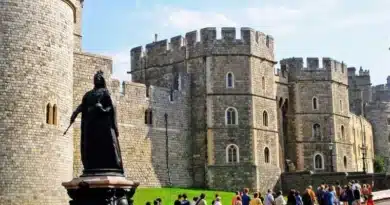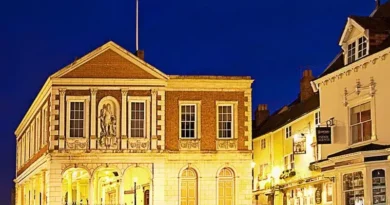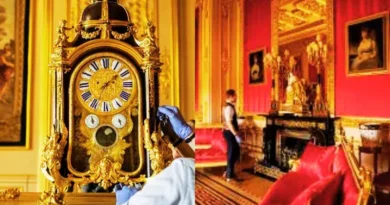How Many Monarchs Are Buried At Windsor Castle?
Eleven British monarchs are currently buried at Windsor Castle, specifically in St. George’s Chapel. This consists of Edward IV, Henry VI, Henry VIII, Charles I, George III, George IV, William IV, Edward VII, George V, George VI, and Elizabeth II.
Key Takeaways
| Monarch | Reign Period | Burial Site | Key Historical Contributions |
|---|---|---|---|
| Edward IV (1442–1483) | 1461–1483 | St. George’s Chapel, North Quire Aisle | Secured victory in the Wars of the Roses; established House of York’s dominance. |
| Henry VI (1421–1471) | 1422–1461, 1470–1471 | St. George’s Chapel, South Quire Aisle | Deposed during the Wars of the Roses; a symbol of Lancastrian rule. |
| Henry VIII (1491–1547) | 1509–1547 | Vault beneath the Quire | Established the Church of England; significant social and governmental reforms. |
| Charles I (1600–1649) | 1625–1649 | Vault near Henry VIII and Jane Seymour | Executed after the English Civil War; his death led to the temporary abolition of the monarchy. |
| George III (1738–1820) | 1760–1820 | Royal Vault, St. George’s Chapel | Lost the American colonies and led Britain through the Napoleonic Wars. |
| George IV (1762–1830) | 1820–1830 | Royal Vault, St. George’s Chapel | Oversaw the Regency period, known for his extravagant lifestyle. |
| William IV (1765–1837) | 1830–1837 | Royal Vault, St. George’s Chapel | Passed significant reforms, including the abolition of slavery and the Reform Act of 1832. |
| Edward VII (1841–1910) | 1901–1910 | St. George’s Chapel, South Quire Aisle | Modernized the British Navy; known as the “Peacemaker” for fostering good relations with European countries, notably through the Entente Cordiale with France in 1904. |
| George V (1865–1936) | 1910–1936 | Royal Vault, St. George’s Chapel | Led the UK during WWI; oversaw the beginning of the British Empire’s dissolution. |
| George VI (1895–1952) | 1936–1952 | King George VI Memorial Chapel | Led the UK through WWII; known for his stoic leadership and unexpected accession. |
| Elizabeth II (1926–2022) | 1952–2022 | King George VI Memorial Chapel | Longest-reigning British monarch; witnessed profound national and global changes. |
Let’s explore this in detail:
Introduction
Windsor Castle, one of the oldest and most historically significant royal residences in the United Kingdom, is a home to British monarchs and a resting place for many of them. The castle’s St. George’s Chapel, an exquisite example of Perpendicular Gothic architecture, is the final resting place of 11 British monarchs, making it one of the country’s most significant royal burial sites.

1. Edward IV (1442–1483)
The first monarch, Edward IV, buried at Windsor, was laid to rest in 1483 in St. George’s Chapel, where his tomb can be found in the North Quire Aisle. His queen, Elizabeth Woodville, joined him in 1492. Edward IV was a key figure in the Wars of the Roses, securing victory for the House of York and establishing a brief period of relative stability in England.
Edward IV (1442–1483) was a central figure in the Wars of the Roses, ascending to the English throne in 1461 after deposing Henry VI. His reign was marked by military successes, notably the decisive victory at the Battle of Towton, which solidified his claim.
Despite initial support from key allies like Richard Neville, Earl of Warwick, tensions arose, particularly after Edward’s secret marriage to Elizabeth Woodville. This alliance led to political rifts, including Warwick’s eventual defection.
Edward’s later years were relatively stable, but his sudden death in 1483, possibly due to pneumonia, left the succession uncertain. His young son, Edward V, was never crowned, leading to Richard III’s controversial rise to power.
Edward IV’s legacy is complex; while he restored relative peace after prolonged civil strife, his unexpected death and the ensuing succession crisis contributed to the continuation of dynastic conflicts in England.
2. Henry VI (1421–1471)
Initially buried in Chertsey Abbey, Richard III transferred Henry VI’s remains to St. George’s Chapel in 1484. His tomb is situated on the South Quire Aisle. Henry VI’s reign was marked by the turmoil of the Wars of the Roses, and his deposition and subsequent murder in the Tower of London remain among the more tragic episodes in English history.
Henry VI (1421–1471) became King of England in 1422, ascending to the throne as an infant following his father’s death. His reign was characterised by the loss of English territories in France, culminating in the end of the Hundred Years’ War. Domestically, his rule was marred by political instability, leading to the Wars of the Roses—a series of civil wars between the houses of Lancaster and York.
Henry’s bouts of mental illness further weakened his position, resulting in his deposition by Edward IV in 1461. Although briefly restored to the throne in 1470, Henry was imprisoned in the Tower of London after Edward IV reclaimed power. He died there in 1471, under circumstances suggesting possible foul play. Despite the turmoil of his reign, Henry VI founded educational institutions, including Eton College and King’s College, Cambridge, leaving a lasting legacy in English education.
3. Henry VIII (1491–1547)
One of the most famous British monarchs, Henry VIII, is interred in a vault beneath the Quire of St. George’s Chapel. He is buried alongside his third wife, Jane Seymour, who died shortly after giving birth to their son, the future Edward VI. The burial site of Henry VIII is a popular point of interest, reflecting his pivotal role in the establishment of the Church of England and the significant changes he brought to English society and governance.
Henry VIII (1491–1547) reigned as King of England from 1509 until his death. He is renowned for his six marriages and his pivotal role in the English Reformation, which led to the establishment of the Church of England. His marriages, particularly to Catherine of Aragon and Anne Boleyn, were central to these religious transformations.
Henry’s reign also saw the expansion of royal authority and significant changes in governance. He was a patron of the arts and initiated the development of the Royal Navy. In his later years, Henry’s health deteriorated, and he became increasingly tyrannical. He passed away in 1547 and was interred in St. George’s Chapel, Windsor Castle, alongside his third wife, Jane Seymour.
4. Charles I (1600–1649)
Charles I was executed after the English Civil War and buried in secrecy at St. George’s Chapel, Windsor Castle. His burial was a sombre affair, largely due to the constraints imposed by his captors, who insisted that the ceremony occur “without pomp or noise.” Contrary to earlier reports, there was no formal recitation of the funeral service from the Book of Common Prayer, a significant omission for such a devout monarch.
Charles I’s body was interred near Henry VIII and Jane Seymour. His burial symbolises a temporary shift as England became a republic under Oliver Cromwell. Some in the Church of England later regarded Charles as a martyr, but he was never officially canonised.
5. George III (1738–1820)
George III, known for losing the American colonies and for his bouts of mental illness, was buried in the Royal Vault beneath St. George’s Chapel. His reign was the third-longest of any British monarch, and his life spanned significant events such as the American Revolution and the Napoleonic Wars.
George III (1738–1820) reigned as King of Great Britain and Ireland from 1760 until his death. His tenure encompassed significant events, including the loss of the American colonies and the Napoleonic Wars. Despite his association with the American Revolution, his direct responsibility for losing the colonies is debated, as he opposed their bid for independence but did not develop the policies leading to war.
In his later years, George III experienced recurrent and eventually permanent mental illness, with historians and medical experts suggesting that his symptoms were consistent with either bipolar disorder or porphyria.
In 1811, his son, the Prince of Wales, was appointed Prince Regent due to the King’s incapacity. George III passed away in 1820 and was interred in the Royal Vault beneath St. George’s Chapel, Windsor Castle.
6. George IV (1762–1830)
The son of George III, George IV, is also buried in the Royal Vault. His reign, though short, was marked by his extravagant lifestyle and the Regency period when he served as Prince Regent during his father’s illness. George IV’s reign saw the continued rise of British influence across the globe despite his personal unpopularity.
George IV (1762–1830), eldest son of George III, served as Prince Regent from 1811 during his father’s illness and ascended the throne in 1820. His tenure, though brief, was characterised by an extravagant lifestyle and significant cultural patronage, notably commissioning the Royal Pavilion in Brighton and the remodelling of Buckingham Palace.
Despite personal unpopularity due to his lavish spending and strained familial relationships, his reign witnessed Britain’s continued global influence, including victory in the Napoleonic Wars. George IV passed away in 1830 and was interred in the Royal Vault beneath St. George’s Chapel, Windsor Castle.
7. William IV (1765–1837)
The younger brother of George IV and the last monarch of the House of Hanover, William IV, was buried in the Royal Vault. Known as the “Sailor King” due to his naval career, William’s reign saw significant political reform, including the abolition of slavery in the British Empire and the passage of the Reform Act of 1832.
William IV (1765–1837), the third son of George III, began his naval career at 13, earning the moniker “Sailor King”. In 1789, he was created Duke of Clarence. He cohabited with actress Dorothea Bland, known as Mrs Jordan, fathering ten illegitimate children. In 1818, he married Princess Adelaide of Saxe-Meiningen; their legitimate offspring did not survive infancy.
Ascending the throne in 1830 at 64, he was the oldest to do so until Charles III in 2022. His reign was marked by significant reforms, notably the abolition of slavery in the British Empire and the Reform Act of 1832, which addressed parliamentary representation. Known for his unpretentious nature, William IV was more approachable than his predecessor, George IV. He passed away in 1837 and was interred in the Royal Vault at St George’s Chapel, Windsor.
8. Edward VII (1841–1910)
Edward VII (1841–1910) reigned as King of the United Kingdom from 1901 until he died in 1910. He is interred in the South Quire Aisle of St. George’s Chapel at Windsor Castle alongside his wife, Queen Alexandra.
Key Historical Contributions:
- Modernization of the British Navy: Edward VII supported Admiral Fisher’s expansion of the Royal Navy, including developing new Dreadnought battleships, ensuring its dominance during the early 20th century.
- Diplomatic Relations: Known as the “Peacemaker,” he strengthened ties with other European nations, notably through the Entente Cordiale with France in 1904, which helped ease longstanding tensions.
- Philanthropy in Health and Medicine: Edward VII’s philanthropic contributions to health and medicine were widely recognized during his time, particularly his support for the Order of St John and other medical charities.
9. George V (1865–1936)
George V, the first monarch of the House of Windsor, was buried in the Royal Vault of St. George’s Chapel following his death in 1936. George V’s reign saw significant changes, including World War I and the beginning of the dissolution of the British Empire. His burial in the Royal Vault at St. George’s Chapel aligns with the tradition of interring British monarchs there. However, the King George VI Memorial Chapel, which was later constructed, became the final resting place for some subsequent royal family members, including King George VI, Queen Elizabeth The Queen Mother, and Queen Elizabeth II.
George V (1865–1936) ascended the throne in 1910, becoming the first monarch of the House of Windsor after renouncing the Germanic ‘Saxe-Coburg and Gotha’ name during World War I.
His reign encompassed significant events, including the First World War, the rise of socialism and fascism, and the initial stages of the British Empire’s transformation into the Commonwealth.
In 1911, he and Queen Mary were crowned Emperor and Empress of India during a grand ceremony in Delhi. George V was interred in the Royal Vault at St. George’s Chapel, Windsor Castle, following his death in 1936.
10. George VI (1895–1952)
George VI, the father of Queen Elizabeth II, is also buried in the King George VI Memorial Chapel. His reign saw the United Kingdom through the Second World War, and his stoic leadership during this period solidified his legacy as a beloved monarch. His unexpected accession to the throne after the abdication of his brother, Edward VIII, marked a turning point in the monarchy.
George VI (1895–1952) ascended the throne unexpectedly in 1936 following his brother Edward VIII’s abdication. Despite a pronounced stammer, he became a symbol of resilience during World War II, delivering morale-boosting speeches that united the nation. His reign witnessed the transition from empire to Commonwealth, with India gaining independence in 1947.
In 1939, he became the first reigning British monarch to visit North America, strengthening UK-US relations. Married to Lady Elizabeth Bowes-Lyon, he fathered two daughters, Elizabeth and Margaret. His health declined post-war, exacerbated by heavy smoking, leading to his death in 1952. He was interred in the King George VI Memorial Chapel at St George’s Chapel, Windsor Castle.
11. Elizabeth II (1926–2022)
The most recent addition to this royal necropolis, Queen Elizabeth II, was buried beside her parents, George VI and the Queen Mother, in the King George VI Memorial Chapel. Her death marked the end of the longest reign of any British monarch, one that saw profound changes in the nation and the world. Her husband, Prince Philip, Duke of Edinburgh, who passed away in 2021, was also interred alongside her.
Queen Elizabeth II (1926–2022) ascended the throne in 1952, becoming the longest-reigning British monarch. Her tenure witnessed significant global transformations, including the decolonisation of Africa and the Caribbean and the UK’s entry into, and later departure from, the European Union. She was the first British monarch to visit China in 1986, marking a milestone in diplomatic relations.
In 2013, under her reign, the Succession to the Crown Act was enacted, ending male preference primogeniture and allowing succession based solely on birth order.
Her commitment to public service was evident as she appointed 15 UK Prime Ministers, from Winston Churchill to Liz Truss.
Her reign was marked by a steadfast dedication to duty, providing continuity and stability amid changing times. Upon her passing, she was interred beside her parents and husband, Prince Philip, in the King George VI Memorial Chapel.
Significance of St. George’s Chapel
For centuries, St. George’s Chapel has been a burial site and a focal point of royal ceremonies, including weddings and funerals. The chapel’s intricate architecture, with its soaring fan vaulting, large stained-glass windows, and ornate woodwork, provides a solemn and fitting atmosphere for the final resting place of British royalty.
George III constructed the chapel’s Royal Vault, which has housed numerous royal family members. However, the more recent tradition has been to bury monarchs and their immediate family members in the King George VI Memorial Chapel, a smaller and more intimate space within St. George’s.
Visitors to Windsor Castle can visit St. George’s Chapel, where they can view the burial sites of these monarchs. The chapel continues to serve as a place of worship and a living part of the British monarchy’s history.
Conclusion
The eleven monarchs buried at Windsor Castle represent a significant portion of British history, each contributing to the nation’s development in various ways. Their burial at St. George’s Chapel, a site steeped in royal tradition, ensures that their legacies remain closely tied to the continuing story of the British monarchy. Windsor Castle remains a powerful symbol of continuity and tradition in the United Kingdom from the medieval period to the modern day.









